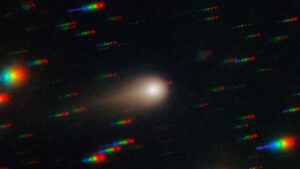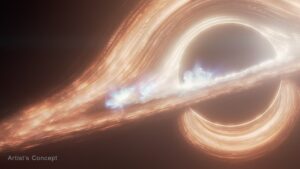
A recent study published in Nature explores the formation of liquid water on exoplanets, providing insights that could significantly impact the search for extraterrestrial life. An international team of scientists conducted laboratory experiments to evaluate how water forms when hydrogen interacts with iron-rich materials beneath the surface of these distant worlds.
To simulate the extreme conditions found on exoplanets, the researchers used a diamond anvil cell and subjected it to high temperatures and pressures, reaching up to 4,000 K (approximately 3,727 degrees Celsius or 6,740 degrees Fahrenheit) and pressures ranging from 16 to 60 gigapascals (GPa). These conditions mimic the interactions between a hydrogen atmosphere and the iron-rich geological features believed to exist on many exoplanets. For context, Earth’s average surface temperature is about 288 K (15 degrees Celsius) at a pressure of 10-4 GPa.
The findings reveal that when a magma ocean rich in hydrogen undergoes a reduction of iron oxide—removing oxygen and converting it to solid iron—substantial quantities of water are generated. This supports existing theories about planetary formation and evolution, suggesting that the presence of liquid water is a natural byproduct of these processes.
Dr. Anat Shahar, a Staff Scientist and Deputy for Research Advancement at the Carnegie Institution for Science, and a co-author of the study, emphasized the significance of these results. “The presence of liquid water is considered critical for planetary habitability. This work demonstrates that large quantities of water are created as a natural consequence of planet formation. It represents a major step forward in how we think about the search for distant worlds capable of hosting life,” she stated.
Identifying Potentially Habitable Exoplanets
The study particularly highlights exoplanets classified as sub-Neptunes, which are defined by their mass lying between that of Earth and Neptune. These planets typically possess rocky interiors like Earth while being enveloped in hydrogen-rich atmospheres akin to Neptune. Approximately 1,000 sub-Neptunes have been identified among more than 6,000 confirmed exoplanets to date, showcasing a variety of characteristics that are not present in our solar system.
Some sub-Neptunes, often referred to as super-Earths, lean more towards Earth’s size and mass. Notable examples of such exoplanets with hydrogen-rich atmospheres located within or near their stars’ habitable zones include K2-18 b, Kepler-138 d, and TOI-270 d. These planets are positioned approximately 124 light-years, 218 light-years, and 73 light-years from Earth, respectively.
These exoplanets orbit M-dwarf stars, which are smaller and cooler than our Sun. Consequently, their habitable zones are also smaller. Interestingly, M-dwarf stars have much longer lifespans—estimated in the trillions of years—compared to the Sun’s approximate 10 billion years.
Broader Implications for Astrobiology
While astronomers have traditionally focused on finding Earth-like planets, this research indicates that exoplanets with different characteristics from our own solar system may still have the potential to support life. The study underscores that water could be more common on exoplanets than previously assumed, challenging long-held assumptions about planetary formation and habitability.
As researchers continue to unravel the complexities of water production on exoplanets, the implications for astrobiology could be profound. The results open new avenues for identifying worlds that might harbor life, whether familiar or entirely alien to our understanding. Future studies are anticipated to expand on these findings, enhancing our comprehension of planetary systems across the universe.
This research illustrates the growing understanding of how various planetary environments can contribute to the conditions necessary for life. With each discovery, scientists move closer to answering fundamental questions about our place in the cosmos.







